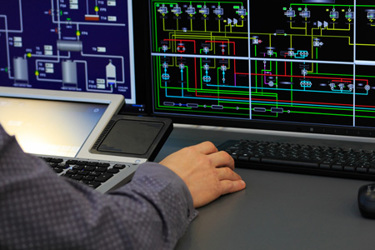SCADA Skills Fuel Smarter Water Grids
By Emily Newton

Supervisory control and data acquisition (SCADA) technology in the water management sector generates excitement because it can tackle some of the industry’s most significant pain points. It complements innovations like the Internet of Things (IoT) and artificial intelligence (AI) in water management, enhancing maintenance efficiency and eliminating downtime. Use these best practices to embrace SCADA and related technologies for a competitive advantage.
Incorporate Real-Time Monitoring And Remote Capabilities
SCADA system components are like security cameras for water professionals, with more utility. The technology allows constant oversight while capturing data about everything, including:
- Temperatures
- Water quality
- Vibrations
- Load fluctuations
- Flow rates
- Pressure
- Tank levels
- Component health
These functions were previously powered by long-range radio and telephones. Now, operators can program control panels to issue remote orders and adjust based on incoming data. Some smart water systems observe trends and automate these changes, such as tightening valves to influence pressure or slowing down movement to control distribution. It prevents load mismanagement and yields higher performance more consistently.
Better Hydraulic Modeling And Calibration Accuracy
The technology can produce accurate models of hydraulic systems as it collects data over time. Higher data density provides more precise insights, informing water workers how to calibrate and validate systems for optimized operations. It can also help adjust connected technologies like transformers and circuit breakers to support better performance.
For example, the visualizations can show system behaviors, such as quality changes and contaminant density after storms or pressure during specific points of the day. The nuances make it easier for the industry to forecast fewer service disruptions.
It could also indicate infrastructure development needs. SCADA reports could generate a model showing the differences between pipes insulated with polyethylene foam and mineral wool. Even if they are made of the same material, details like insulation can impact performance and alter calibration needs. Eventually, providers may discover what performs better and adjust retrofitting and new construction plans based on these findings.
Sophisticated Pump Station Controls
SCADA enables more advanced pump control setups to make a bigger impact. Peripherals like variable frequency drives (VFDs) and proportional-integral-derivative (PID) loops are simpler to program and become more accurate with SCADA’s real-time oversight.
PID controllers constantly generate error values by observing the planned outcomes against measured variables. Melding these with SCADA systems gives operators more flexibility when adjusting setpoints and parameters. It could also reduce false safety alarms. The increased data accuracy will help discover anomalies signifying genuine concerns.
VFDs improve water management by streamlining the transportation and treatment of sewage. The motors adjust their speed and torque based on the pump’s contents, preventing blockages and material degradation by slowing down flows that could cause bursts. SCADA can automate VFD adjustments to boost efficiency during low-flow conditions and exercise greater care during high strain. The combination should save energy, prolong equipment life, and yield quality-of-life improvements, like less water hammer.
Leak Detection With AI In Water Management
Leaks are one of the prominent causes of financial and performance losses in water transmission and treatment systems. Integrating AI in water management and SCADA equipment reduces the chances of this happening. One case study in Brazil demonstrated how SCADA worked seamlessly with digital twins to enhance leak discovery and eliminate data silos.
AI has predictive analytics functions that could identify leaks before they occur. Sensors, cameras, and SCADA infrastructure combine with the program to notice small splinters forming in pipes or gauge when an old pipe has reached the end of its lifespan based on performance metrics. It helps professionals tackle issues before they exacerbate or cause disruptions, whether it be a patch job or segment replacement.
The number of costly repairs from burst pipes lowers and water losses — especially in areas experiencing scarcity and high demand — are less concerning. Eventually, an AI model can outline the leak patterns with enough specificity to prevent most leaks.
Data-Driven Decision-Making
Process discovery in a utility company or wastewater treatment plant can be more confident because of SCADA and smart water systems. Remove the guesswork of deciding the best workflow changes and digital transformation installations to make by using the data in SCADA systems to outline goals.
Many plants use these predictive controls to prevent membrane fouling and optimize desalination. An AI determines the intake water quality against equipment behavior to find the optimal plan.
The amount of historical and incoming data is invaluable in determining the next steps for growth. It encourages enterprises to take scaling to the next level, making higher-risk choices with a greater chance of success, including for significant infrastructure investments.
SCADA information can help alleviate the burdens water is experiencing due to its current labor shortage. Seventy-five percent of employers suggest they are struggling to find workers with the right soft skills. These could include qualities like critical thinking, which is vital for a rapidly developing, tech-driven industry like water. Smart systems supplement these needs as they upskill workers and their analytics literacy.
Faster Emergency Response And Triage
Critical infrastructure like water systems is subject to numerous threats, including physical destruction from natural disasters and cybersecurity attacks. As infrastructure expands, the number of vulnerable points and attack surface area increases. The industry must leverage technology to have as much 24/7 surveillance as possible, and SCADA simplifies these observations.
It can rapidly assess a large area in a short period, cutting workers’ number of manual interventions and travel hours. Organizations can pinpoint the most vulnerable infrastructure and customers during an emerging disaster, like a hacker-induced shutdown or unexpected winter freeze. Then, they can quickly redirect affected systems, find alternative water sources, and communicate with stakeholders.
Optimized Chemical Dosing
Water treatment facilities must carefully distribute chemicals to maintain trustworthy and safe quality. Reducing chemical reagents is a current priority for most water businesses, and advanced activated sludge models with SCADA programs are faster at discovering microbial activity and simulating dosing needs. It can even eliminate dangers posed by common paint points like biofilm accumulation.
SCADA systems are programmable to the current recommendations from compliance agencies and can measure existing chemical levels and disperse additional treatment technologies as necessary. Doing so prevents overuse while tightening quality control parameters.
Chemical dosing problems caused by human error are avoidable because SCADA can automate controls based on contaminants and other metrics. Adjusting output makes operations leaner and more sustainable, saving money and resources.
Automated Valve Manipulation
Valves are some of the most critical fixtures in water management, yet they need frequent adjustments and maintenance. SCADA can communicate with remote access systems and controllers, even sending information to operators’ phones and tablets. These interfaces give workers constant access to every valve’s health and positioning.
This agency is important for several reasons. For example, AI tools in water management may still be early in their integration. They become proficient as they learn, leaving the early days of use open for more mistakes. Automated valve manipulation through SCADA allows manual overrides of inaccurate remote adjustments issued through automation.
Workers can also use the valve controls to isolate flows if stressors cause an emergency. If dangerous pollutants, pressure levels, or structural compromises exist, technicians can shut off specific zones for faster incident response with minimal adverse side effects.
Smart Water Systems Of The Future
SCADA’s data collection, transmission, and visualization capabilities enable the next generation of water management. Technicians can remain connected to their infrastructure with remote terminals and controls, saving hours of manual inspection. Instruments are likelier to run at peak efficiency for longer, as alarm monitoring and remote controls keep uptime to near-perfect levels. The future requires this level of productivity to shoulder utility demands and distribute resources smartly to its constituents.
 Emily Newton is an industrial journalist. She regularly covers stories for the utilities and energy sectors. Emily is also editor in chief of Revolutionized (revolutionized.com).
Emily Newton is an industrial journalist. She regularly covers stories for the utilities and energy sectors. Emily is also editor in chief of Revolutionized (revolutionized.com).
